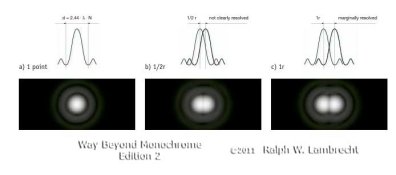Athiril
A49 is correct, you are not using the right equation.
Use resolution = 1/(1.22 * wavelength * N) to get max resolution. Using only mm and 555 nm for green light, it will return 5.8 lp/mm for f/256, which is, as I said, borderline to A49 proposed value.
I hope you can accept this 'pseudo scientist' proposal.
You still need to multiply that by 1000 to get it up to mm, otherwise you are calculator single points per um, rather than line pairs for mm.
In any event that os the formula for the smallest point of detail.
1 lp = a pair of points.
Therefore 1 lp = 2 points. Therefore you still divide that by 2.
And even if you didn't. The values are still wrong, because his f/22 value is 75% of his f/11 value instead of 50%.
And if you didn't divide by 2, the f/11 value would be, most formula use 450 nm for a reason.
In fact, his f/11 value is using 450 nm as a value, its 80 lp/mm. If you didn't divide by 2 for lp/mm, his f/11 value should be 165.6 lp/mm, or 160 lp/mm in his rounded case, when you dont divide it by 2 (which is incorrect not to do)
For 555 nm f/11 would be 67 lp/mm, or if you incorrectly not divide by 2, it should be 134 lp/mm.
His values are way off. And the value should halve for every 2 f-stops given the above equation you gave, no matter how you use it with what wavelength.
IE: Given what you give above the chart would become the follow:
(converted from um to mm, and not accounting for the fact lp/mm is a pair of lines, and the above equation is for single points, not pairs, where you should divide by 2)
555 nm, 1 lp/mm counted as 1 point
f-stop --- resolution ---
11 ------ 134.25 lp/mm -------
16 ------ 92.3 lp/mm -------
22 ------ 67.13 lp/mm -------
32 ------ 46.15 lp/mm -------
45 ------ 32.82 lp/mm -------
64 ------ 14 lp/mm -------
90 ------ 23.08 lp/mm -------
128 ----- 11.54 lp/mm -------
180 ------ 8.2 lp/mm -------
256 ------ 5.8 lp/mm -------
Now you might think f/256 should be 5.8 lp/mm but this is the chart for the equation you give using 0.555 nm, you can see how wrong it is, and you should see where A49's chart is way off, it is completely inconsistent in values. f/11 = 80, but f/22 = 60? f/16 = 70, but f/32 = 45?
Compare it to the chart he gave:
f-stop --- resolution --- CoC
11 ------ 80 lpm ------- 0,013 mm
16 ------ 70 lpm ------- 0,014 mm
22 ------ 60 lpm ------- 0,017 mm
32 ------ 45 lpm ------- 0,022 mm
45 ------ 30 lpm ------- 0,033 mm
64 ------ 22 lpm ------- 0,045 mm
90 ------ 15 lpm ------- 0,067 mm
128 ----- 11 lpm ------- 0,091 mm
180 ------ 8 lpm ------- 0,13 mm
256 ------ 6 lpm ------- 0,17 mm
His values are not consistent with the equation for 555 nm and not dividing by 2.
In fact his f/11 value is 450nm and dividing by 2 (like it should be).












